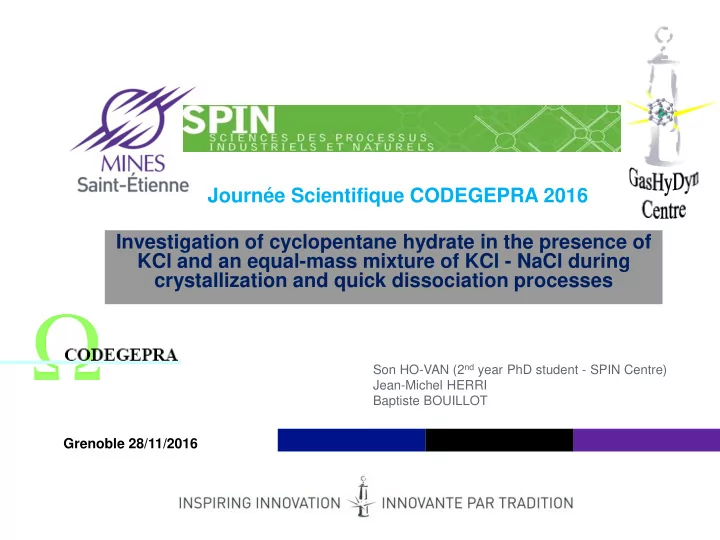

Journée Scientifique CODEGEPRA 2016 Investigation of cyclopentane hydrate in the presence of KCl and an equal-mass mixture of KCl - NaCl during crystallization and quick dissociation processes Son HO-VAN (2 nd year PhD student - SPIN Centre) Jean-Michel HERRI Baptiste BOUILLOT Grenoble 28/11/2016 1 Institut Mines-Télécom
Introduction http://www.lngworldnews.com/nord-stream-completes-second-underwater-baltic-sea-gas- pipeline/ Hydrate – based desalination Underwater pipeline oil and gas Offshore well, CP hydrate can http://www.sketch-d.com/Underwater- natural gas form at Pipeline-Illustration-Schlumberger transportation 2 , atmospheric pressure at 280K Offshore oil and gas – Platforms CO 2 sequestration 3 http://new.abb.com/oil-and-gas/sectors/offshore-oil-and-gas/platforms CP hydrate could A huge amount of Study CP be used to model gas hydrate in hydrate in the hydrate formation ocean sediments 1 from oil/gas presence of (1 – 5)x10 15 m 3 of emulsion in salts CH 4 +CO 2 hydrates Hydrate formation and plugging pipelines in the oil-dominated system, Hydrate structure D. Turner, K. Miller, E. D. Sloan 2009 Clathrate hydrates Hydrate structure Guest molecule Cavity types Water molecules Investigation of CP Cage hydrate in KCl and a mixture of KCl - NaCl Objective during crystallisation and quick dissociation processes Guest molucule The five cavity types and the three common unit crystals structures of the clathrate hydrates (E. Dendy Sloan and Jr, 2003; English and MacElroy, 2015) 1. Milkov, A. V.: Global estimates of hydrate-bound gas in marine sediments: how much is really out there?, Earth-Sci. Rev., 66, 183 – 197, doi:10.1016/j.earscirev.2003.11.002, 2004 2. Mimachi, H., Takeya, S., Yoneyama, A., Hyodo, K., Takeda, T., Gotoh, Y., Murayama, T., 2014. Natural gas storage and transportation within gas hydrate of smaller particle: Size dependence of self-preservation phenomenon of natural gas hydrate. Chem. Eng. Sci. 118, 208 – 213. doi:10.1016/j.ces.2014.07.050 3. A. Yamasaki, M. Wakatsuki, H. Teng, 1998. A new ocean disposal scenario for anthropogenic CO2: CO2 hydrate formation in a submerged crystallizer and its disposal. Energy. 4.Bradshaw, R.W., Greathouse, J.A., Cygan, R.T., Simmons, B.A., Dedrick, D.E., Majzoub, E.H., 2008. Desalination Utilizing Clathrate Hydrates (LDRD Final Report). Investigation of CP hydrate in the presence of KCl and an equal- 2 28/11/2016 Institut Mines-Télécom mass mixture of KCl and NaCl
Experimental protocol 8. Temperature transmitter 1. Reactor 9. Computer 2. Cryostat 10. Temperature probe 3. Impeller 11. Conductivity probe 4. Agitator 12. Drying oven 5. Cooling jacket 13. Ion chromatography 6. Conductivity transmitter 14. Camera 7. Motor Experimental apparatus system Experimental protocol Taking photos 1 ml Colling 1 hour 5 ml Initiate by injecting ice Observation 2-3 g 1 -2 hours Taking samplesc Simplified schematic diagram of experimental apparatus system Investigation of CP hydrate in the presence of KCl and an equal- 3 28/11/2016 Institut Mines-Télécom mass mixture of KCl and NaCl
Results and discussions Image of the Image of the Temperature and conductivity profiles of solution at solution at Temperature and conductivity profiles of CP hydrate 225 min CP hydrate experiment in pure water 70 min experiment in 3,5% KCl 18 2,5 25 60 16 Temperature Conductivity, mS/cm Conductivity, mS/cm 2 20 50 14 Temperature, °C Conductivity 12 Temperature, °C 1,5 15 40 10 Formation 8 Te = 7,7°C 1 10 30 Hydrate formation 6 4 Temperature 0,5 5 20 Exothermic Te = 6°C 2 Exothermic Conductivity Endothermic Endothermic 0 0 0 10 0 100 200 300 400 500 Elapsed time, min -5 0 Injected ice Elapsed time, min 0 50 100 150 200 250 300 Injected ice Temperature and conductivity profile of CP hydarte 25 experiment in 3,5% KCl and NaCl 60 Temperature and conductivity profiles of CP hydrate experiment in 20% KCl 25 200 Conductivity, mS/cm 20 50 Temperature 20 Dissociation Formation Temperature, °C Dissociation Temperature, °C Conductivity 15 150 15 40 Conductivity, mS/cm 10 10 30 5 100 T, °C 0 Conductivity 5 20 0 1000 2000 3000 4000 5000 -5 50 Te = 5,9°C Hydrate formation -10 0 10 -15 0 0 100 200 300 400 Te = -2,1°C Elapsed time, min -5 0 Elapsed time, min Injected ice Investigation of CP hydrate in the presence of KCl and an equal- 4 28/11/2016 Institut Mines-Télécom mass mixture of KCl and NaCl
Equilibrium temperature of cyclopentane hydrate 10 In the presence of NaCl - following a quick dissociation procedure In the presence of an equal-mass mixture KCl and NaCl - following a quick dissociation procedure 5 In the presence of NaCl - following a slow dissociation procedure Temperature, ° C In the presence of KCl - following a quick 0 dissociation procedure -5 -10 -15 0 2 4 6 8 10 12 14 16 18 20 22 24 26 28 Salt concentration, % w/w The equilibrium temperature of cyclopentane hydrate in the presence of salts Conclusions 1. An increase in temperature was observed during cyclopentane hydrate formation because of the exothermic property of this process 2. When hydrate dissociated strongly, the temperature was nearly constant due to the heat-releasing from the dissociation process 3. The conductivity had illogical tendencies owing to the appearance of hydrate solids 4. When no hydrate was observed inside the vessel, the temperature immediately increased due to heating from the environment around 5. The equilibrium temperature dropped strongly with increasing of salt concentration in all cases 6. The equilibrium temperatures of Cp hydrate in the presence of KCl were always higher than in the presence of an equal-mass mixture of KCl - NaCl and in the presence of only NaCl following both quick and slow dissociation procedures at the same salt concentration. Investigation of CP hydrate in the presence of KCl and an equal- 5 28/11/2016 Institut Mines-Télécom mass mixture of KCl and NaCl
Thank you very much for your attention Investigation of CP hydrate in the presence of KCl and an equal- 6 28/11/2016 Institut Mines-Télécom mass mixture of KCl and NaCl
Recommend
More recommend